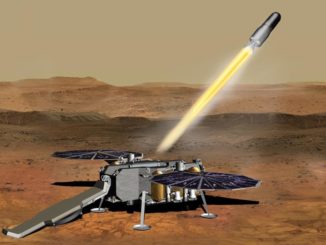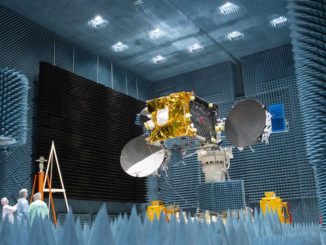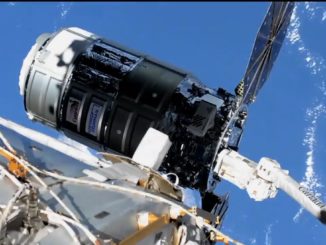We’re streaming live views from Starbase, Texas, in partnership with LabPadre.
The Federal Aviation Administration approved a commercial license Friday for the first full-scale test flight of SpaceX’s nearly 400-foot-tall Super Heavy and Starship mega-rocket from South Texas, a launch SpaceX said could happen as soon as Monday morning.
“After a comprehensive license evaluation process, the FAA determined SpaceX met all safety, environmental, policy, payload, airspace integration and financial responsibility requirements,” the FAA said Friday. “The license is valid for five years.”
The launch license only covers the first test flight of the Super Heavy booster and Starship vehicle. Following the FAA’s launch license announcement Friday, SpaceX immediately tweeted it was targeting Monday morning for the test flight, with a two-and-a-half hour launch window opening at 7 a.m. CDT (8 a.m. EDT; 1200 UTC).
A cluster of 33 methane-fueled Raptor engines, each generating about a half-million pounds of thrust, will power the rocket off the pad for its inaugural test flight. The Super Heavy booster will burn its engines for 2 minutes and 49 seconds, then separate from the Starship upper stage. The booster will re-light its engines for a series of maneuvers to attempt a controlled splashdown about 20 miles (30 kilometers) off the coast of Texas.
Six Raptor engines are mounted to the Starship upper stage. Those engines will accelerate Starship to near orbital velocity, and the vehicle will coast around the world before falling back through the atmosphere over the Pacific Ocean, eventually impacting north of Hawaii around 90 minutes after liftoff. An FAA official said the Starship could reach a maximum altitude of 146 miles (235 kilometers), below the height of the International Space Station, and will not reach the speed required to enter a stable orbit.
Eventually, SpaceX wants to recover both the Super Heavy booster and the Starship vehicle after each flight, making the rocket fully reusable. For the first test flight, both parts of the rocket will be expended.

An FAA spokesperson said the Starship vehicle will not perform any propulsion maneuvers during its descent toward splashdown in the Pacific, but will have attitude control capability “using other means.”
But that assumes all goes according to plan on the test flight. SpaceX has performed several sub-scale launches of Starship prototypes, but those flights remained inside Earth’s atmosphere. The Super Heavy booster, which stands taller than the Falcon 9 rocket SpaceX uses to launch crews to the space station, has never left the ground.
“A mishap is part of our business, and it’s a pretty realistic possibility,” an FAA official said. “We see this quite often with first launches of new, and somewhat unproven space vehicles.”
“Success maybe, excitement guaranteed!” tweeted Elon Musk, SpaceX’s founder and CEO.
“We’re hoping for a safe launch, but you never know where things might break or when things might go wrong, and I think we have really good mitigations in place looking at all the potential hazards that could occur during launch,” the FAA officials said. “And I think we’ve done a good job of making sure that we have our arms around that.”
SpaceX will clear an area extending roughly 4 miles from the Starship launch site, known as Starbase, ensuring non-essential personnel and the public remain well clear of the blast danger area. The rocket has an autonomous flight safety system that would destroy the vehicle if it veered off course and threatens populated areas.

The FAA is responsible for ensuring public safety during commercial launch and re-entry operations by U.S. companies. The agency announced last year that it would require SpaceX to take more than 75 actions to reduce the environmental effects of flying its Starship rocket from South Texas. But not all of the mitigation steps were required before the FAA issued a commercial launch license to SpaceX for the first Starship orbital test flight.
“We’ve been well over 500 days of review on this one particular license application,” an FAA official said.
“I think we’ve put considerable resources on this particular project,” the FAA official said. “It’s a very complicated project. It’s the largest rocket that this office will have ever licensed. It’s a complicated machine. The flight safety aspects of the review are pretty important.”
The official said SpaceX made changes to its license application for the Super Heavy / Starship test flight, requiring the FAA to take more time evaluating the proposal.
“This particular program is dynamic,” the FAA official said. “It’s a test program. SpaceX has done a lot of tinkering along the way, I would say, and as a result of that, the application has undergone multiple changes.”
The changes not only included modifications to the vehicle design, but alterations to the test flight’s trajectory to minimize public safety risk, the FAA official said.
“So each time the application changes, we don’t have to do a complete restart, but we have to take a fresh look at different things in accordance to the regulations to ensure that we’re not missing anything,” the officials said. “So that’s really been a major factor in the amount of time that it’s taken to get this review completed.”
The FAA licensing process includes a series of reviews, including a policy review with other federal agencies, and a safety review to evaluate a launch operator’s approach to ensuring an accident would not harm the people or property owned by third parties. The FAA also requires launch companies to obtain insurance to cover third-party claims in the event of a catastrophic launch failure.
The FAA official said the agency and SpaceX had a “good dialogue” back and forth throughout the licensing process. “We’re in constant conversation with SpaceX daily.”
For the Super Heavy / Starship integrated test flight, the FAA requires SpaceX obtain an insurance policy of at least $500 million to cover claims third-party property damage caused by an in-flight failure of the rocket, and $48 million for third-party claims resulting from an anomaly during pre-flight preparations.
FAA safety inspectors will be on site at SpaceX’s launch facility, called Starbase, to ensure SpaceX is complying with federal public safety requirements.
“We carefully analyzed the public safety risks during every stage of the mission and required SpaceX to mitigate those risks,” the FAA said in a statement Friday. “In addition, the FAA will implement various airspace integration measures designed to reduce the impact of the launch on commercial airline flights and other airspace users.”
The FAA will close and reopen airspace to commercial air traffic as the rocket makes its way around the world, with aircraft exclusion zones mapped out near the Texas launch site and the impact area near Hawaii.
The FAA said the Starship vehicle and the Super Heavy booster will transmit telemetry data to the agency. “Data such as position, altitude, speed and any deviation from its expected flight path will provide the FAA situational awareness, and in combination with other information, help to reopen airspace quicker,” the agency said.
Once the rocket is proven, SpaceX wants to use the Starship vehicle to deploy the company’s Starlink internet satellites, flying heavier, next-generation versions of the broadband relay stations than the spacecraft now being launched by the smaller Falcon 9 rocket. An animation released from SpaceX showed the company’s concept for deploying Starlink satellites from a Starship vehicle in orbit, using a mechanism that works like a giant Pez dispenser.
SpaceX has also won a $2.9 billion contract with NASA to develop the Starship into a human-rated lander for the agency’s Artemis moon missions. A moon derivative of the Starship, assisted by Starship refueling tankers, will be utilized for a lunar landing with astronauts, an event NASA says could happen no earlier than 2025. SpaceX also has a deal with Japanese billionaire Yusaku Maezawa to send a team of private citizens around the moon on a Starship flight.
Flights of the Starship beyond low Earth orbit will require the still-untested in-orbit refueling capability SpaceX is developing for the new-generation rocket.
There is no operational payload on the Starship’s first space mission set for next week. The rocket will not achieve orbit, and the vehicle’s payload bay door has been welded shut.
Email the author.
Follow Stephen Clark on Twitter: @StephenClark1.



